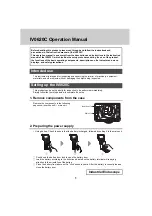
CET Electric Technology
56
Chapter 4
Applications
4.1
Inputs and Outputs
4.1.1
Digital Inputs
The iMeter 6 comes standard with six self-excited Digital Inputs that are internally wetted at 24 VDC with a
sampling frequency of 1000Hz and programmable debounce. The iMeter 6 provides the following programmable
functions for its Digital Inputs:
1)
Digital Input
Digital Inputs are typically used for status monitoring which can help prevent
equipment damage, improve maintenance, and track security breaches. The
real-time statuses of the Digital Inputs are available on the Front Panel LCD
Display as well as through communications. Changes in Digital Input status are
stored as events in the SOE Log in 1 ms resolution.
2)
Pulse Counting
Pulse counting is supported with programmable pulse weight and facilitates
WAGES (Water, Air, Gas, Electricity and Steam) information collection.
3)
Demand Sync Pulse
One of the Digital Inputs can be programmed to receive Demand Sync Pulse.
Please refer to
Section 4.2.5
for a detailed description. Only the last DI will
control the Demand Sync if there are multiple DIs are programmed as
SYNC DI
.
For example, if DI2, DI3 and DI5 are all set to Demand Sync Input, only DI5 will
be used for Demand Sync.
4)
Time Synchronization
DI6 can be used as an external time synchronization input. Please refer to
Section
for a detailed description.
5)
Tariff Switching
Up to 3 Digital Inputs may be used to select to which of the 8 Tariffs the energy
consumption should be accumulated. The 3 Digital Inputs (DI1 to DI3) represent
3 binary digits where Tariff 1=000, Tariff 2=001, …, Tariff 8=111 where DI1
represents the least significant digit and DI3 represents the most significant digit.
The
DI1 Function
setup register must first be programmed as a
Tariff Switch
before configuring DI2 with the same function. In other words, if DI1 is
configured as a
Digital Input
or
Energy Pulse Counter
and DI2 is configured as a
Tariff Switch
, the TOU will continue to function based on the TOU Schedule.
The following table describes the DI’s setup parameters:
Setup Parameter
Definition
Options/*Default
DIx Function
Each
DI
can be configured as a Status Input, Pulse Counter, SYNC
DI or 1 PPS. Only DI1 to DI3 can be set as
Tariff Switch
.
0=Status Input*
1=Pulse Counter
2=SYNC DI, 3=1 PPS
4=Tariff Switch
DIx Debounce
Specifies the minimum duration the
DI
must remain in the Active
or Inactive state before a state change is considered to be valid.
1 to 1000 (ms)
(Default=20ms)
DIx Pulse Weight
Specifies the incremental value for each received pulse. This is
only used when a DI is configured as a Pulse Counter.
1* to 1,000,000
Table 4-1 DI Setup Parameters
4.1.2
Digital Outputs
The iMeter 6 comes standard with three Form A Electromechanical Digital Outputs. Digital Outputs are normally
used for setpoint alarming, load control, or Remote Control applications.
Digital Outputs on the iMeter 6 can be used in the following applications:
1)
Front Panel Control
Manually operated from the Front Panel. Please refer to the
DO Control
setup
parameter in
Section 3.1.3.5.8 f
or a detailed description.
2)
Remote Control
Remotely operated over communications via the built-in Web Interface, our free
PMC Setup software or the PecStar® iEMS Integrated Energy Management
System.
3)
Control Setpoint
Control setpoints can be programmed to trigger DO, Data Recorder, Waveform
Recorder or Alarm Email upon becoming active. Please refer to
Section 4.4
for a
detailed description.
















































